We finally got out of the house last weekend for two nights of camping. This being almost winter already, we chose Salt Pond Beach Park near Hanapepe to be on the warm west side, and it didn’t disappoint. We arrived Friday evening, and put up the tent just before sunset.
We didn’t plan on doing much, but not having plans left us open to whatever came up. First was the Hanapepe Art Night, like every Friday night from 6 to 9pm. All the art galleries and shops stay open late, many have snacks or cheese and crackers with wine (or juice or water) .
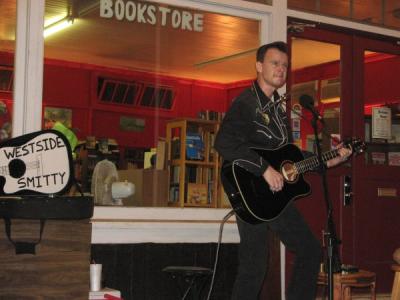 |
There is usually a musician playing in front of one of the stores, last Friday it was Westside Smitty playing some “Kaua‘i blues, folk, harmonica and steel guitar” in front of the Talk Story bookstore. He wrote some Kaua’i-flavored lyrics to some old classics and was a lot of fun to listen to. Unfortunately, he’s off to the east coast nursing home circuit for a few months, but he’ll be back next year.
Of course, I could not resist going into the bookstore and buying a book. |
We tried to eat at the Hanapepe Cafe, a casual restaurant serving simple yet creative food with lots of vegetarian choices, but reservations are a must on Friday nights (335-5011). We ended up a the local eatery next door which looked like a greasy spoon. But they were very friendly, and the food was greasy but good. And they obviously cater to vegetarians who were turned away at the Cafe.
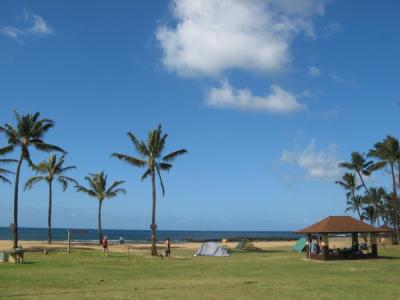 |
This was the view from our tent, looking out towards the beach. There are no marked camp-spots, but there are plenty of picnic tables, pavilions, sinks and water faucets around. |
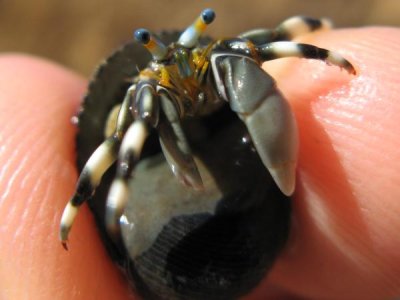 |
The most common inhabitant of the tide pools is the hermit crab.
In one section where the large pools were separated by smaller dry ones, lots of little crabs gathered for some reason known only to them. I must’ve scared them, because they all ran away when I got near. I call this movie March of the Crabs (20MB—please be patient): |
Snorkeling is not spectacular, but there are some fish in the shallow rocks to the left inside the exposed rocks. The lifeguards advised me not to go outside the inlent due to strong currents in the opening. The water can be murky due to the wash over the reef, mornings are usually calmer and clearer.
You’ll see a good variety of fish, just not many of each. I saw some bluestripe and milletseed butterflyfish, some kihi kihi (moorish idol), and one Hawaiian cleaner wrasse. On a previous trip, back before my underwater camera broke, I saw this odd fish called a flying gurnard. The “wings” are spread to scare me away, but the fish does not fly:
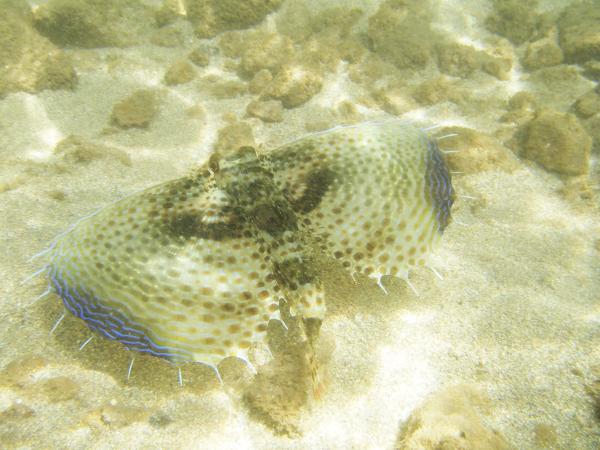
It seems like we filled up the day just walking a little, going for a swim, and relaxing. The next day, we set out to explore around Hanapepe again.
|
||
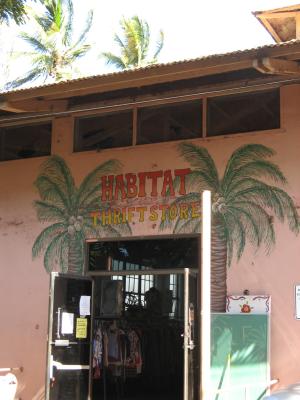 |
Being November still, it was hot in the sun all afternoon, so we went shopping. Hanapepe has the only thrift stores south of Lihue, and we love to check them out.
There is a small—and somewhat grimy—Salvation Army store (turn makai next to the Shell station), and Habitat for Humanity, the house building organization, has a store in a large warehouse right near the trun-off to Salt Pond. This is the best thrift store on the island, the perfect antithesis of the other Habitat, a trendy European competitor to Ikea. In the end, we found some really cheap clothes and some good children’s books. |
Back at the campground, the late afternoon sun was making the salt ponds very photogenic again:
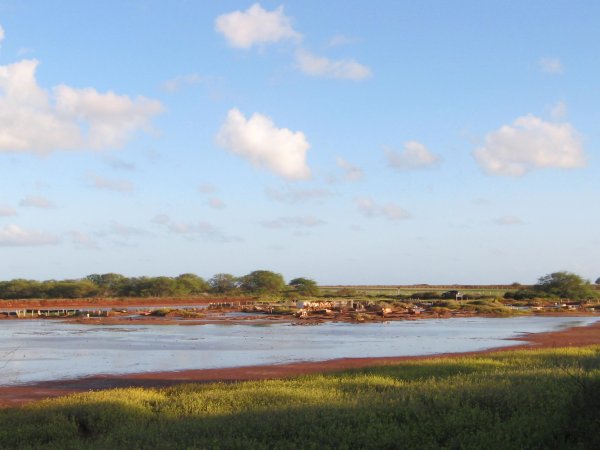
I’m not really sure how the salt ponds operate, but I think I heard that salt water seeps in under the sand from the ocean nearby, and then it’s concentrated into smaller and smaller pans shaped directly in the red clay. The clay keeps the water from going back out, and in the end the brine dries up leaving the coarse salt crystals. The salt is scraped out of the pans and left unwashed, giving it a pinkish color, though not nearly as red as the “commercial” ‘alaea sea salt in which red clay is added to coarse white sea salt.
I believe that the Hanapepe salt ponds are the only traditional salt-making ponds remaining in Hawaii. The right to make salt there is restricted to several families, like a guild, and passed down though the generations. Additionally, this salt cannot be bought or sold by these families, only given away. In addition to seasoning, the salt is used for Hawaiian blessings and ceremonies, at least it was in the old days and I assume some people still honor the practice.
So the highlight of the weekend was receiving a small bag of the salt from one of the more-or-less homeless campers who live around the beach park. She had let us share her picnic table, we offered her some of our food and chatted with her occasionally, and by the end of the weekend she gave us some authentic local salt to take home. I suppose she belongs to one of the families or knows them well. I don’t want to make too much of the gift, but it does feel special to us.
Then a double rainbow appeared over the salt ponds:

It sprinkled a little, but not enough to get the tent wet, which was fortunate because it was time to pack up. After that, the nice sunset was a bit anticlimactic, but I won’t complain.

We stopped at Grinds Café in ‘Ele’ele for dinner. I have been dissapointed by their pizza before (too much greasy cheese), but their sandwiches and breakfast-anytime dishes were very tasty this time. Their homemade bread was so good, we took a loaf home with us.
In the end, we went to places that we knew from before, but each in its own way had something new for us. It was nearly the perfect weekend, with the right mix of rest, relaxation, and mini-adventures, right in Kaua’i’s backyard.
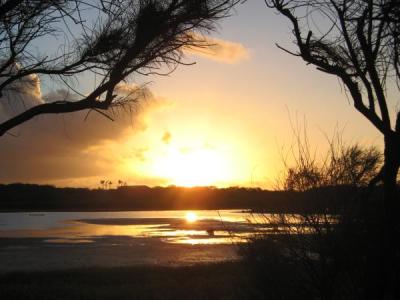
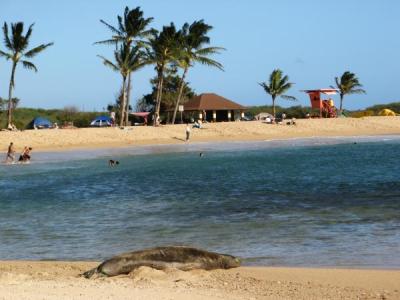
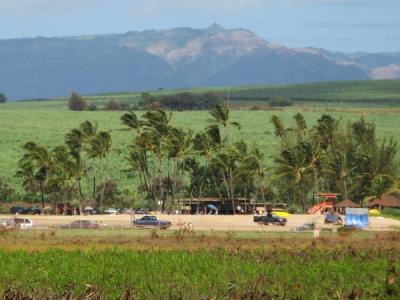
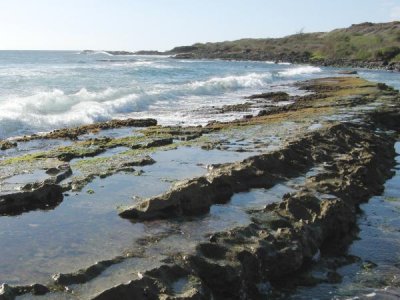
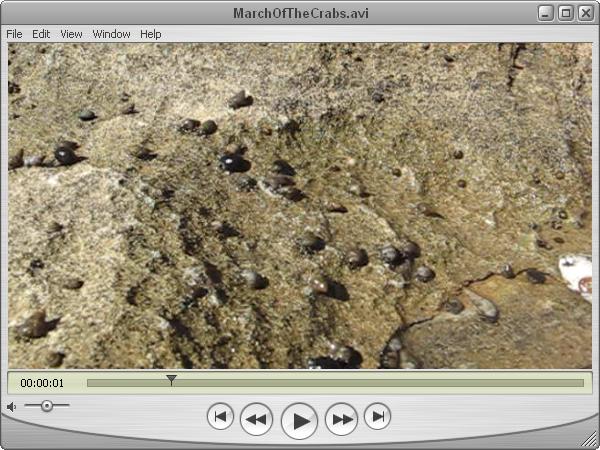
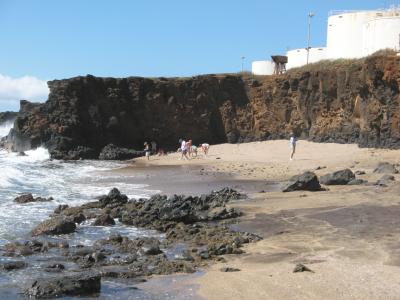
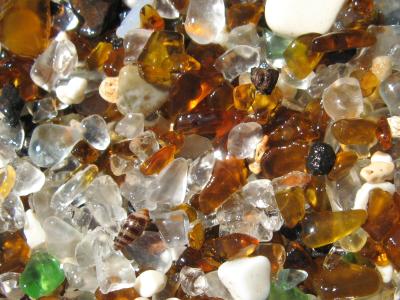
Actually, that “sharing” homeless person is probably just taking the sale from the rightfull owners…the families that work many, many hours to make the salt in the traditional was. One of those saltmakers is a good friend and he says that theft of salt is a constant problem there. Unfortunately, one can’t be there 24/7 to protect the delicate salt beds unless one chooses to squat on the beach and poach the fruits of others’ labors.
The salt pans are carefully made. A pan is dug, then carefully lined with clay over a period of time to make it able to holed the brackish water that’s under the surface. Then the saltmaker must transfer buckets of clear brackish water from another hole to fill the pan. Once the water evaporates leaving the salt, more water is poured in by bucket from a neighboring (usually deep) hole. This process goes on for months before the salt crust is thick enough to be able to harvest the salt without also scraping up the clay on which it rests. So months of regular and back-breaking work are required to make one productive salt pan. Once the salt crust is ready for harvesting, it is carefully scraped off and placed on drying sheets in the sun.
It’s really sad that some people have no compunction against stealing from honest hardworking folks who are trying to keep their ancestors traditions and cultural practices alive.
Aloha,
Many homeless people are kind, hardworking and full of Aloha. Such a beautiful story about the gift. There is theft, but no thieves are going to share their Pa?akai. The auntie was gifted or worked the pans herself, then gifted you. I had to comment because I wanted to erase the negative impression staining the aunties intention. People are very humble, giving, kind no matter their circumstances….that is true aloha.